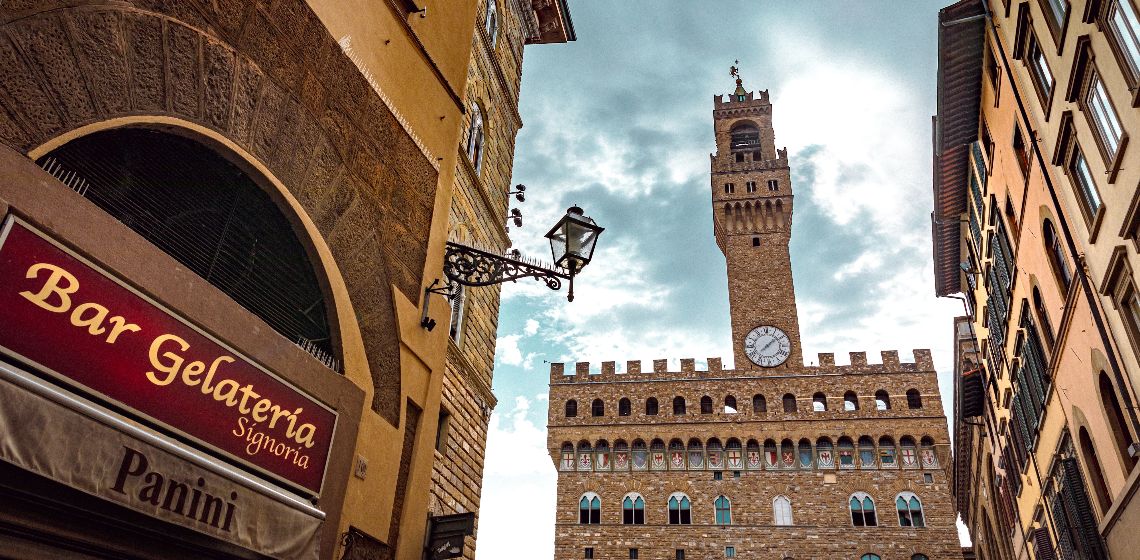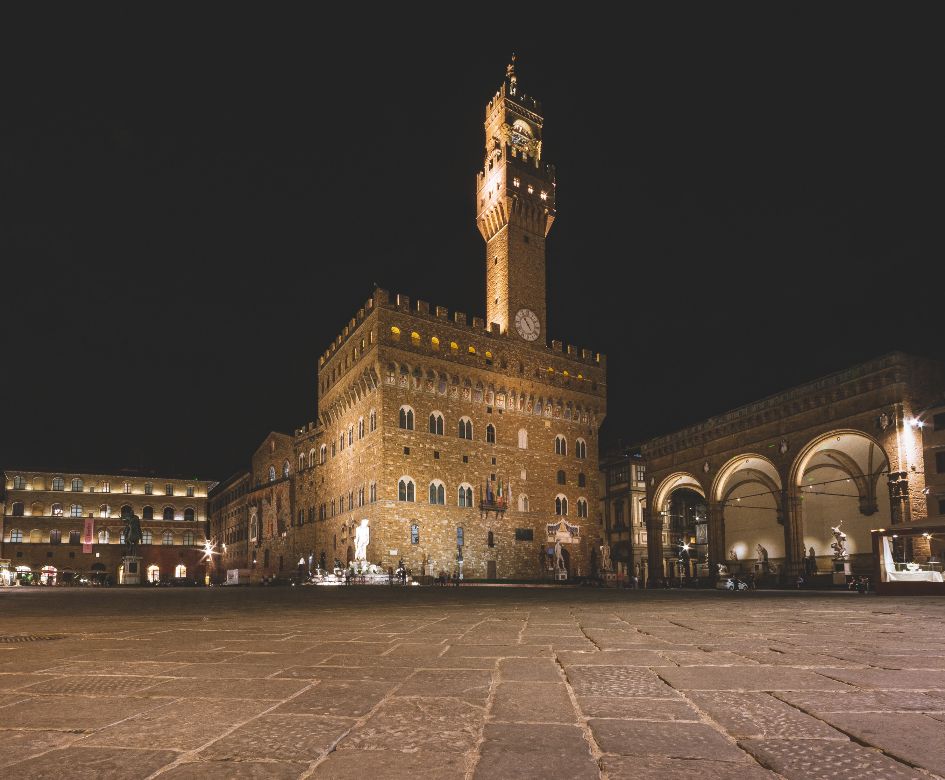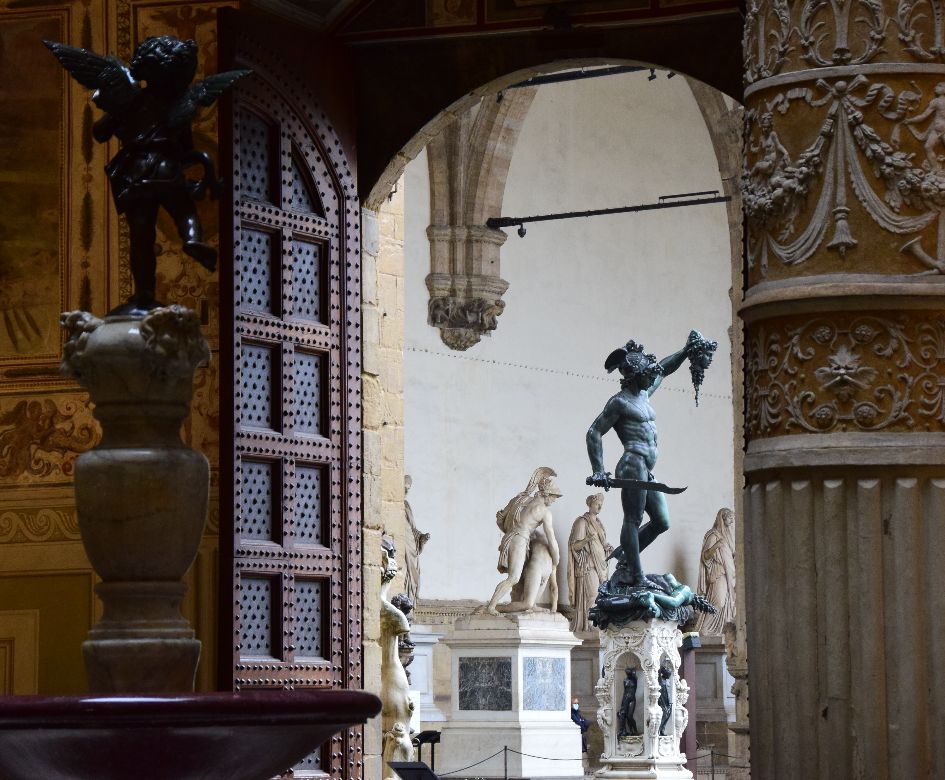
Piazza della Signoria, Florence’s veritable open-air museum
Let us take you through the sculptural, architectural and historical masterpieces in the world-renowned piazza.
At the very heart of Florence, you’ll find Piazza della Signoria. Created as a symbol of Medici power and with immense artistic magnificence, the square is home to the headquarters of the municipality of Florence, Palazzo Vecchio, and is also the setting for statues and works that seem almost life-like.
Palazzo Vecchio
The site for city decisions is now also an intriguing museum right in the centre of the square. The characteristic tower of Palazzo Vecchio was built between 1299 and 1314 in a project by Arnolfo di Cambio, giving a fitting location for the Priori delle Arti (Priors of the Arts) who governed the city, also giving their name to the square which was then called Piazza dei Priori.
Under the dominion of the Medici, Cosimo, upon his wife Eleonora’s request, appointed Vasari to transform it into a sumptuous palace and it became the official seat of the Signoria (political leaders in Medieval and Renaissance Florence). It was called Palazzo Ducale until 1565, when Cosimo I decided to move to the "new" Palazzo Pitti and took to calling it vecchio (old).
We are immediately greeted with incredible sights once we enter the elegant courtyard, heading to the spectacular Salone del Cinquecento and the complex of the Quartieri Monumentali, frescoed by Ghirlandaio, Salviati, Bronzino and Vasari and embellished with sculptures by Michelangelo and Donatello.
Read more: Palazzo Vecchio, history, rooms, secrets.
Other buildings overlooking the characteristically L-shaped square are the fourteenth-century Tribunale della Mercanzia, Palazzo Uguccioni (dating to 1550), and the more recent Palazzo delle Assicurazioni Generali, built in 1871 in a neo-Renaissance style.

The statues of David and La Loggia dei Lanzi
The statues in Piazza della Signoria are not only of the highest artistic level, but also fascinating allegorically. The representations were intended to inspire the leaders of the city who attended Palazzo Vecchio, and political themes are a common thread throughout the works.
The giant copy of the statue of Michelangelo’s David dominates the space in front of the palace, symbolizing independence and strength. At his side, you can admire the oldest statues in the square, Donatello’s Il Marzocco, and Giuditta and Oloferne (c. 1455-60) which represent Florence and the political autonomy of the Florentine Republic respectively.
Other political subjects in the wonderful Loggia dei Lanzi include Benvenuto Cellini's Perseus with the head of Medusa, and Giambologna’s Hercules and the Centaur, and the Rape of the Sabines.

The Biancone, the famous fountain of Neptune
The piazza is home to the magnificent statue of Cosimo I on horseback, a bronze work also made by Giambologna (1594), and the Fountain of Neptune created in 1559 by Bartolomeo Ammannati upon the Grand Duchy of Tuscany’s successful achievement of maritime goals.
The statue of Neptune came to be called the Biancone by locals, made from white Carrara marble and standing candidly to the left of Palazzo Vecchio on his pedestal decorated with the statues of Scilla and Charybdis in the centre of the octagonal basin. The god of the sea bears features reminiscent of Cosimo I de 'Medici, an example of the Medici’s projection of their greatness through art.
The corners of the basin feature groups of marine divinities (Teti, Doride, Oceano and Nereo), each of which have a procession of bronze nymphs, satyrs and fauns by Giambologna at their feet. These sophisticated masterpieces of Florentine mannerism add incredibly rich detail to the awe-inspiring works, fitting for the remarkable Piazza della Signoria that draws gasps from every angle.






 All the services are provided by local merchants
All the services are provided by local merchants By using this site you support Florence
By using this site you support Florence We offer products with high-quality standards
We offer products with high-quality standards You stay sustainable
You stay sustainable It's a 100% trustworthy website
It's a 100% trustworthy website